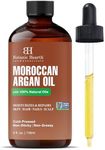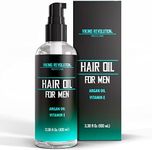Buying Guide for the Best Hair Oils
Choosing the right hair oil can make a big difference in the health and appearance of your hair. Hair oils serve various purposes, such as moisturizing, strengthening, adding shine, or addressing scalp issues. The best way to pick a hair oil is to consider your hair type, your main hair concerns, and how you plan to use the oil. Understanding the key features of hair oils will help you make a choice that fits your needs and gives you the best results.Oil TypeOil type refers to the main ingredient or base of the hair oil, such as coconut, argan, jojoba, almond, or castor oil. Each oil type has unique properties: for example, coconut oil is deeply moisturizing, argan oil is lightweight and adds shine, and castor oil is known for promoting hair growth. To navigate this, think about your hair's needs—if your hair is dry, heavier oils like coconut or olive may be best; for fine or oily hair, lighter oils like argan or grapeseed are preferable. Choose an oil type that matches your hair goals and texture.
IngredientsIngredients in hair oils can include pure oils, blends of several oils, and added components like essential oils, vitamins, or silicones. This is important because some ingredients can nourish the scalp, while others may just coat the hair for shine. If you have sensitive skin or allergies, look for simple, natural ingredient lists. If you want extra benefits like fragrance or scalp stimulation, consider oils with added essential oils or vitamins. Always check the ingredient list to ensure it aligns with your preferences and sensitivities.
Absorption RateAbsorption rate describes how quickly the oil soaks into your hair and scalp. Fast-absorbing oils like argan or jojoba are great for daily use and won’t leave hair greasy, while slow-absorbing oils like castor or olive are better for deep treatments or overnight use. If you want a leave-in oil that won’t weigh your hair down, go for a fast-absorbing option. For intensive moisture or scalp treatments, a slower-absorbing oil may be more effective.
ScentScent refers to the fragrance of the hair oil, which can range from neutral to strongly perfumed. This is important because the scent will linger in your hair, and some people are sensitive to strong fragrances. If you prefer a natural or unscented product, look for oils without added perfumes. If you enjoy a pleasant aroma, choose oils with natural essential oils or light fragrances. Your personal preference and sensitivity to scents should guide your choice here.
Intended UseIntended use means whether the oil is designed for scalp treatments, hair ends, frizz control, heat protection, or overall nourishment. Some oils are multipurpose, while others are formulated for specific needs. If you want to treat dandruff or a dry scalp, look for oils meant for scalp application. For split ends or shine, pick oils designed for hair lengths and ends. Think about your main hair concern and select an oil that targets that issue.
Texture and ConsistencyTexture and consistency refer to how thick or thin the oil feels. Thicker oils can be more nourishing but may feel heavy, while lighter oils are easier to spread and absorb quickly. If you have fine or oily hair, lighter oils are less likely to weigh your hair down. For thick, curly, or very dry hair, a richer, thicker oil can provide more moisture and control. Match the oil’s texture to your hair type and how you plan to use it.




















